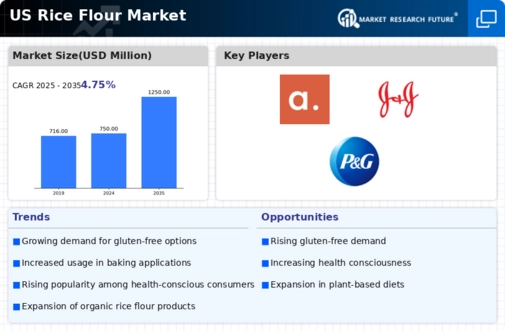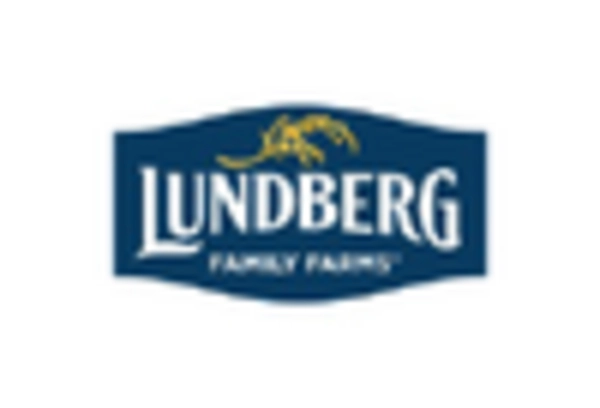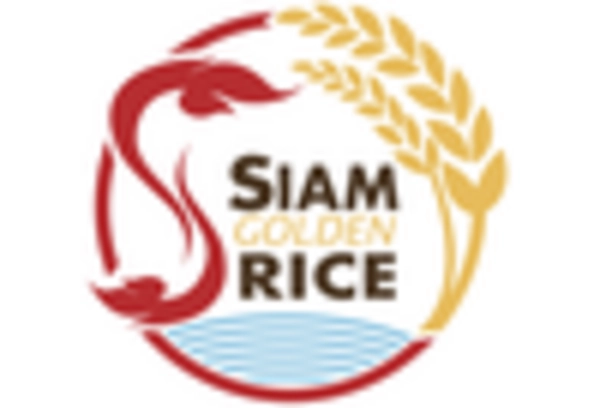Innovation in Food Products
Innovation within the food sector is a significant driver for the rice flour market. Manufacturers are increasingly developing new products that incorporate rice flour, such as snacks, baked goods, and ready-to-eat meals. This trend is indicative of a broader movement towards diversifying food offerings to cater to various dietary preferences. For instance, the introduction of rice flour-based pasta and gluten-free baked goods has expanded the market's reach. According to recent data, the introduction of innovative rice flour products has contributed to a 15% increase in market share within the gluten-free segment. The rice flour market is thus positioned to capitalize on this trend, as consumers are drawn to novel food experiences that align with their dietary needs. This ongoing innovation is expected to sustain growth and attract new customers.
Health Consciousness Among Consumers
The increasing awareness of health and wellness among consumers is driving the rice flour market. As individuals seek healthier alternatives to traditional wheat flour, rice flour is gaining traction due to its gluten-free nature and lower allergenic potential. This shift in consumer behavior is reflected in market data, indicating that the demand for gluten-free products has surged by approximately 30% in recent years. The rice flour market is benefiting from this trend, as more consumers incorporate rice flour into their diets for its perceived health benefits. Additionally, the rise of health-focused diets, such as paleo and keto, further supports the growth of rice flour as a versatile ingredient in various recipes. This heightened health consciousness is likely to continue influencing purchasing decisions, thereby propelling the rice flour market forward.
Increased Availability of Rice Flour
The enhanced availability of rice flour in retail and online platforms is a crucial driver for the rice flour market. As consumer demand rises, retailers are expanding their product lines to include a variety of rice flour options, including organic and specialty blends. This increased accessibility is reflected in market data, which indicates a 25% growth in the number of retail outlets offering rice flour products over the past year. The rice flour market is benefiting from this trend, as consumers are more likely to purchase products that are readily available. Furthermore, the rise of e-commerce has facilitated access to rice flour for consumers who may not find it in local stores. This trend is expected to continue, as convenience and availability play a significant role in consumer purchasing behavior.
Culinary Trends Favoring Asian Cuisine
The rising interest in Asian cuisine is a notable driver for the rice flour market. As consumers become more adventurous in their culinary choices, the demand for authentic Asian dishes that utilize rice flour is increasing. This trend is evident in the growing popularity of products such as rice noodles, dumplings, and desserts made from rice flour. Market data suggests that the Asian food segment is experiencing a growth rate of approximately 18% annually, which positively impacts the rice flour market. The incorporation of rice flour in these dishes not only caters to taste preferences but also aligns with dietary restrictions, such as gluten intolerance. As culinary trends continue to evolve, the rice flour market is likely to benefit from the sustained interest in Asian cuisine.
Rising Popularity of Plant-Based Diets
The growing trend towards plant-based diets is significantly impacting the rice flour market. As more consumers adopt vegetarian and vegan lifestyles, the demand for plant-based ingredients has surged. Rice flour, being a plant-derived product, aligns well with these dietary choices. Market analysis suggests that the plant-based food sector is projected to grow by over 20% in the coming years, which bodes well for the rice flour market. This shift is not only driven by health considerations but also by environmental concerns, as consumers seek sustainable food options. The versatility of rice flour in various culinary applications, from baking to thickening sauces, makes it an attractive choice for those pursuing plant-based diets. Consequently, the rice flour market is likely to experience sustained growth as it caters to this expanding consumer base.

















Leave a Comment